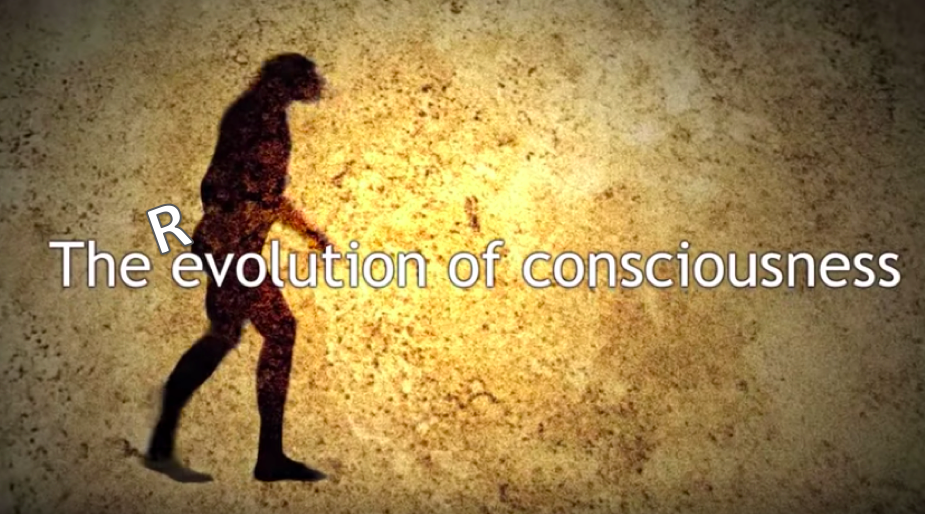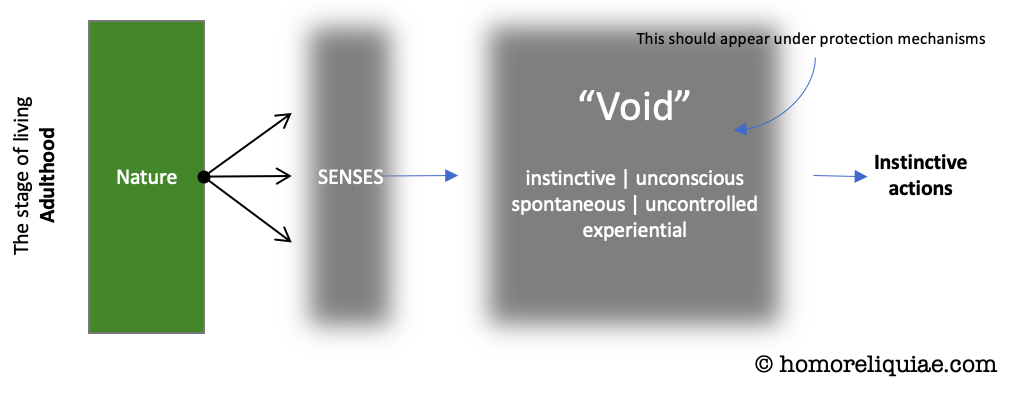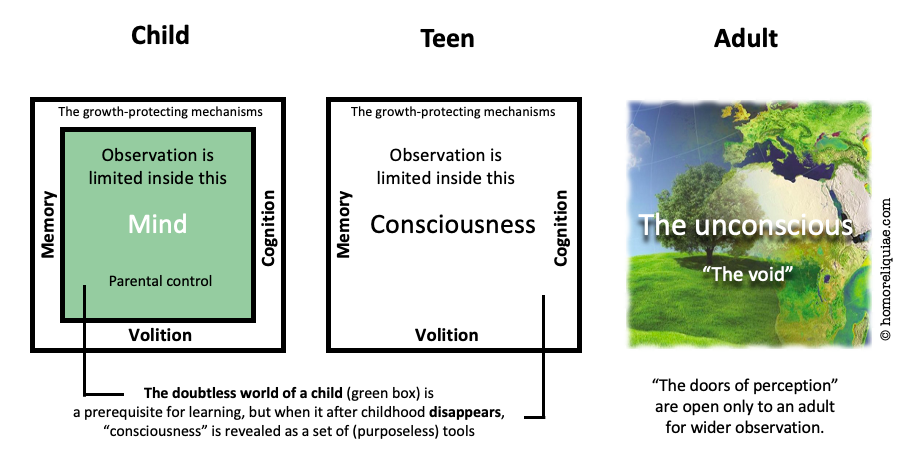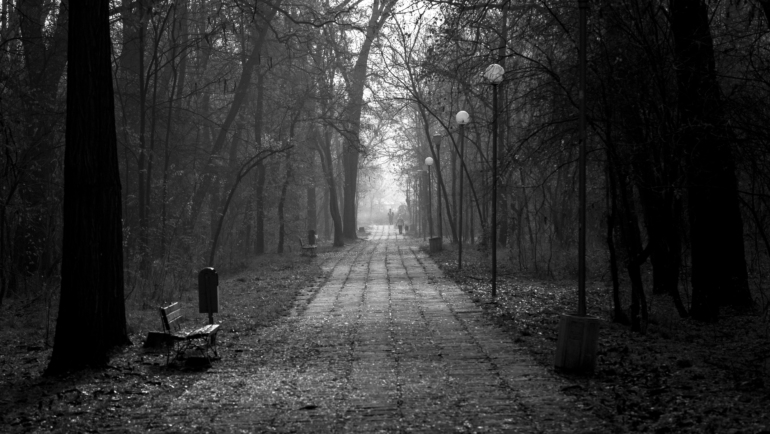The article argues that consciousness is an intermediary stage between childhood and adulthood, meant to protect and guide our growth but should eventually disappear. However, due to the rebellion of our defective ancestors against their extinction, consciousness remains and prevents us from fully becoming adults. Additionally, the article suggests that our understanding of consciousness is flawed and human-centred and that true adulthood involves connecting with nature and accepting the irrational.
Everyday consciousness works as scaffolding for our growing mind
Certain peculiarities in our personal growth and development offer an exciting opportunity for the interpretation of consciousness. First, it is worth noting that, unlike psychedelic experiences, the spontaneous changes in the state of consciousness provide us with the key to the causes of this change! Second, the end of our puberty leaves us in strange uncertainty and confusion. We expect change, but nothing happens. This confusion will discern the fundamental nature of consciousness, which tells us that the final stage of our growth fails. Surprisingly, these events are related. They not only help to understand how consciousness works but also show how it should work. This difference is more significant than we dare to imagine.
Consciousness is easy to understand by a parable from the house construction world. Imagine it as scaffolding. The purpose of this temporary structure is to enable the safe and appropriate completion of complex construction sites. It will be dismantled when the building is ready to be taken for its proper use. Likewise, consciousness is a structure that should serve as a temporary aid; that is, consciousness should disappear as the individual grows up. However, something is wrong, so the “scaffolding consciousness” does not disappear. While it persists, it prevents the original and efficient use of our “building body” and makes us creatures who wonder about the world and our existence.

The juvenile mind, which we know best as consciousness, can be seen as scaffolding designed to enable the safe and appropriate completion of a building (i.e. an individual). Scaffolding is meant to be temporary, and the conscious mind should work the same way and disappear as soon as one is fully grown up. (Photo by bernswaelz, pixabay.com)
We do not regard scaffolding consciousness as a support and protection mechanism because it looks more like a rare and mythically constructed protrusion that all other living beings seem to lack. For us, it is the crown jewel of our unique human quality. If we understood that the purpose of consciousness is only to protect our growth, we would also know that an adult person does not need consciousness to live. But if not, we will be in the middle of the most imaginative theories. From the child’s point of view, consciousness makes sense. And maybe that’s why we explain an adult as a kind of “child extension”. However, that is not the case. Childhood is the stage of construction, adulthood is the stage of life, and these should be completely separate. It isn’t easy to understand that adults should live without a rational mind just through direct observation and instincts. However, houses are not made for scaffolding; on the contrary, scaffolding is made for houses. Consciousness is a means or a tool, not the goal of our development.
Persistent cognition means recession
The adult mind contains several mechanisms that secure growth by manipulating the interaction with the environment in a safe direction. Nature has provided “filters” and “restraints” for the child’s consciousness, the purpose of which is to simplify the experience of the outside world and facilitate the child’s reactions. These mechanisms aim not to show the world correctly but to help survive. Nor is the child allowed to experience the world directly but merely compare things with the images in his mind and memory. Cognition is a children’s tool for monitoring their environment, a comparison is a tool for learning, and learning is their way to survive.
The function of consciousness is to cover the child’s senses during the growing-up period, thus preventing them from experiencing the true complexity of the world, which would be fatal at an early age. Consciousness makes the world rational and causal for fast and secure predictability. I’ve depicted the unconscious mind as a hidden and shadowed area behind the conscious. As we grow up, we only experience the cover (consciousness), not what is behind it. Because we are aware only of the conscious, we shall focus only on that. But the stronger it becomes, the more will be our unconscious mind hidden. And the less we will understand it. That is what Zen’s paradoxes are all about: we cannot achieve peace of mind with the help of the conscious mind. If you are lucky, you can eliminate it and see what’s behind it.
The conscious mind is for children only
In adults, consciousness prevents them from acting as adults should. The protective mechanisms do not remain the same but tend to change slightly. The real problem arises only during puberty. The early teens show a few weak signs of change: parents lose their role, the young people begin to explore themselves and their environment, and learning ability ceases as childhood certainty disappears.
The child’s inherent self-centeredness evolves into the ego, the memory becomes the identity, and the comparative mechanism becomes the reason. These mental changes produce the state of mind we call consciousness or self-awareness. It is—or should be—an intermediate stage between childhood and adulthood and is probably the result of the prolonged childhood of homo species. Changes from childhood to adulthood may have sometimes occurred without teen-like intermediate stages. Human mental development ends at this stage. The final step should be (and once it has been) to dismantle the scaffolding and get the building (body) ready for the use for which it was built, but this will never happen. There are, however, some exceptions where the change to adulthood starts but is not completed. We call these momentary changes in the psyche mystical experiences.
The comparison mechanism produces learning. Both belong together with parents’ existence because the children learn quickly only by taking their environment for granted. And it’s the parents that make this happen. The child never questions his parents but is mentally attached to them. Therefore, “parents” are a mere protection mechanism in the child’s mind. But as the child moves away from his parents, learning will be impaired. The certainty will be replaced by the child’s self-awareness and the endless search for life. Thus, humans will remain permanently unfinished.
It’s very human to understand mental changes as development. The human psyche may change, but consciousness won’t. Either it exists or doesn’t exist. Some of the mind mechanisms can stop working; if that happens, one loses the ability to manage volition, cognition and memory. It is usually seen not only as a liberating state but also as the disappearance of something. It is precisely the consciousness that disappears. At first, a sight usually feels like a “void”. It leaves you alone with your direct observations. Then you finally understand what life is all about. As our psyche changes, our consciousness does not change or expand but, instead, disappears and revives the millions of years old Heidelberg’s psyche. The experience nullifies all of one’s imagined human superiority, but it gives back something much more: it brings him back to life. The so-called development of consciousness is merely a human-centred fantasy and doesn’t seem to hold water. Consciousness neither change nor develop: all the artefacts it brings about, from stone tools to space rockets, result from the same consciousness.

In the Heidelberg man’s struggle against the harsh environment, consciousness meant the postponement of extinction. And it still means the same to us. The conflict was partially successful. The rebellious child-minded individuals survived, and the adults died. The child’s mind was critical in rescuing a few individuals who became our human ancestors. Since man ceased to evolve, survival should instead be called the revolution of consciousness, not evolution.
Our psyche consists of many individual mechanisms designed to protect us in the delicate time of our growth. They appear to us, among other things, as consciousness. Their job is to protect us as we grow and then vanish. However, we know that consciousness does not disappear. It remains because our defective ancestors rebelled against their extinction for thousands of years and thus escaped natural selection. Our spiritual aspirations turned into weird, irrational mysticism, paranormal fantasies, mighty deities, and, to some extent, forgiving love. Civilisation cut off real adulthood connections with nature, so religions became human-centred, externally shiny, and polished. Our young mind came to misunderstand all mysticism. Urbanisation and schooling further increased the heavily biased admiration of youth, with agricultural regions being more moderate. The original, natural, irrational adulthood became another name for chaos, the primitive and insane. The cost of survival was high; man ceased to understand himself.






